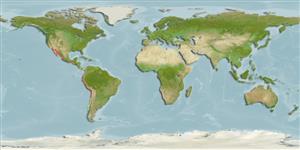Classification / Names
Common names | Synonyms | Catalog of Fishes (gen., sp.) | ITIS | CoL | WoRMS | Cloffa
Actinopterygii (ray-finned fishes) >
Ophidiiformes (Cusk eels) >
Bythitidae (Viviparous brotulas) > Bythitinae
Etymology: Parasaccogaster: Name refers to the similarity to Saccogaster.. More on author: Cohen, Nielsen.
Environment / Climate / Range
Ecology
Marine; demersal; depth range 80 - 150 m (Ref. 93007). Tropical, preferred ?
Southeast Pacific: off Peru to Costa Rica.
Size / Weight / Age
Maturity: Lm ? range ? - ? cm
Max length : 14.2 cm (female)
Short description
Morphology | Morphometrics
Dorsal
soft rays
(total): 83-87;
Anal
soft rays: 51 - 54;
Vertebrae: 54 - 56. This species is distinguished from it congeners by the following characters: gill filaments on anterior arch is 4-5 times the length of the developed rakers; a pair of very small, subdermal, closely set spines on frontal plate above and behind eyes, absence of spine on ethmoid; anterior arch with 2-3 developed rakers, not much longer than spiny knobs; gill filaments on anterior arch 4-5 times length of developed rakers; palatines 2-4 tooth rows; prolonged pectoral peduncle adnate to body; vertebrae, precaudal 14-16 and total 54-56; fin rays, D 83-87, A 51-54, caudal 12-13, pectoral 17-19 (Ref. 93007).
Rare species, known from two specimens (Ref. 34024). A viviparous species living on the lower part of the continental shelf (80-150 m). Four examined female specimens are with well-developed eggs but apparently no embryos. Sections of ripe testes show that the spermatozoans are arranged in spermatophores (Ref. 93007).
Life cycle and mating behavior
Maturity | Reproduction | Spawning | Eggs | Fecundity | Larvae
Nielsen, J.G., W. Schwarzhans and D.M. Cohen, 2012. Revisions of Hastatobythites and Saccogaster (Teleostei, Bythitidae) with three new species and a new genus. Zootaxa 3579:1-36. (Ref. 93007)
IUCN Red List Status (Ref. 115185)
CITES (Ref. 94142)
Not Evaluated
Threat to humans
Harmless
Human uses
Fisheries: of no interest
More information
Common namesSynonymsMetabolismPredatorsEcotoxicologyReproductionMaturitySpawningFecundityEggsEgg development
Age/SizeGrowthLength-weightLength-lengthLength-frequenciesMorphometricsMorphologyLarvaeLarval dynamicsRecruitmentAbundance
ReferencesAquacultureAquaculture profileStrainsGeneticsAllele frequenciesHeritabilityDiseasesProcessingMass conversion
Tools
Special reports
Download XML
Internet sources
